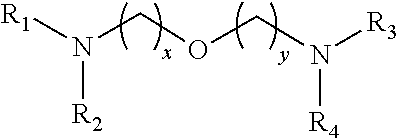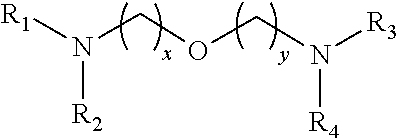Reactive amine catalysts for polyurethane foam
a technology of reactive amine and polyurethane foam, which is applied in the field of urethane catalysts, can solve the problems of high density foam with a high percentage of poorly defined cells, unstable foam, and foam collapse, and achieve the effects of improving foaming times, improving tack free times, and improving cream times
- Summary
- Abstract
- Description
- Claims
- Application Information
AI Technical Summary
Benefits of technology
Problems solved by technology
Method used
Image
Examples
examples i-vii
[0057]These examples illustrate the use of the catalysts of this invention as catalysts in TDI-based molded flexible foam applications. Examples I-IV are comparative examples Example I is an example of a fugitive catalyst system with a trace of a nonfugative catalyst (JEFFCAT™ ZF-10) in the system Example II-IV are examples of reactive catalyst (non fugitive catalyst) used to make the foam. Examples V-VII illustrate the use of Experimental Catalyst 1 in combination with several different reactive gelling catalysts. The results are given in Table 1 below.
[0058]The cell opener is a high molecular weight polyether polyol with more than 45% ethylene oxide content but less than 80% ethylene oxide. The remainder of the oxide is propylene oxide. The initiator can be glycerol or other polyhydric alcohol. DEOA is a stabilizer used in foams and is known art.
[0059]The control catalysts are JEFFCAT(R)ZF-22 and JEFFCAT(R) TD-33A. The control catalysts are standard practice in the urethane indust...
examples xi-xiv
[0066]These examples illustrate the use of the catalysts of this invention as catalysts in a standard flexible slabstock foam application. Examples XI and XII are comparative examples. Examples XIII and XIV illustrate the use of Experimental Catalysts 1 & 2 in combination with a typical gelling catalyst. The results are given in Table 3 below.
[0067]
TABLE 3Evaluation of catalysts in a standardflexible slabstock foam formulationExampleXIXIIXIIIXIV3100 MW mixed EO / PO triol100100100100Water4.84.84.84.8Silicone Surfactant1.01.01.01.0JEFFCAT ® ZF-TD33A catalyst0.150.150.150.15tin 2-ethylhexanoate0.270.270.270.27(50% solution)JEFFCAT ® ZF-22 catalyst0.046JEFFCAT ® ZF-10 catalyst0.084Experimental Catalyst 10.15Experimental Catalyst 20.15TDI (Index 1.1)60.5360.5360.5360.53Reaction ProfileCream time, s14151514Top of Cup, s64697264Blow Off Time, s92889389Physical PropertiesDensity, pcf1.31.31.3Air flow, scfm6.877.1IFD, lb / 50 sq inch25%33.633.931.665%61.561.956.9Return 25%23.223.421.8Compressio...
examples xv-xvii
[0069]These examples illustrate the use of the catalysts of this invention as catalysts in a viscoelastic foam application. Example XV is a comparative example. Examples XVI and XVII illustrate the use of Experimental Catalysts 1 and 2 in combination with a typical gelling catalyst. The results are given in Table 4 below.
[0070]
TABLE 4Evaluation of catalysts in viscoelastic foam formulationExampleXVXVIXVII3100 MW mixed EO / PO triol303030700 MW PO triol7070705000 MW high EO content triol777Cell OpenerWater1.951.951.95Viscoelastic Surfactant1.01.01.0DMEA0.220.220.22JEFFCAT ® ZF-TD33A catalyst0.290.290.29tin 2-ethylhexanoate0.140.140.14(50% solution)JEFFCAT ® ZF-22 catalyst0.22JEFFCAT ® ZF-10 catalystExperimental Catalyst 10.48Experimental Catalyst 20.48TDI (Index 0.85)40.340.340.3Reaction ProfileCream time, s121515Top of Cup, s457366Blow Off Time, s114139126Physical PropertiesDensity, pcf33.13.3Air flow, scfm1.10.41Resiliency, %4.24.55.5Odor Panel ResultsAverage rating on a scale of 1 t...
PUM
| Property | Measurement | Unit |
|---|---|---|
| weight percent | aaaaa | aaaaa |
| weight percent | aaaaa | aaaaa |
| mold temperature | aaaaa | aaaaa |
Abstract
Description
Claims
Application Information
 Login to View More
Login to View More - R&D
- Intellectual Property
- Life Sciences
- Materials
- Tech Scout
- Unparalleled Data Quality
- Higher Quality Content
- 60% Fewer Hallucinations
Browse by: Latest US Patents, China's latest patents, Technical Efficacy Thesaurus, Application Domain, Technology Topic, Popular Technical Reports.
© 2025 PatSnap. All rights reserved.Legal|Privacy policy|Modern Slavery Act Transparency Statement|Sitemap|About US| Contact US: help@patsnap.com


